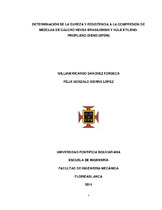| dc.contributor.advisor | Director. Santos Jaimes, Alfonso | |
| dc.contributor.author | Sánchez Fonseca, William Ricardo | |
| dc.contributor.author | Sierra López, Félix Gonzalo | |
| dc.coverage.temporal | 2014 | |
| dc.date.accessioned | 2022-05-03T16:23:30Z | |
| dc.date.available | 2022-05-03T16:23:30Z | |
| dc.date.issued | 2014-03 | |
| dc.identifier.uri | http://hdl.handle.net/20.500.11912/10006 | |
| dc.description | 88p.: (pdf); il; imágenes; gráficas; tablas; anexos. | spa |
| dc.description.abstract | El proyecto de grado “DETERMINACIÓN DE LA DUREZA Y RESISTENCIA A LA COMPRESIÓN DE MEZCLAS DE CAUCHO HEVEA BRASILIENSIS Y HULE ETILENO-PROPILENO-DIENO (EPDM)” tiene como objetivo efectuar la caracterización mecánica de la mezcla de caucho natural Heveas Brasiliensis y el hule Etileno-Propileno-Dieno EPDM a través de ensayos de dureza Shore y resistencia a la compresión.
Durante el desarrollo del presente proyecto se realizó la construcción de una máquina vulcanizadora de caucho funcional, tomando como guía los planos del diseño por parte de 2 estudiantes de Ingeniería Mecánica de la Universidad Pontificia Bolivariana, seccional Bucaramanga.
Se fabricaron 10 probetas con diferentes porcentajes de mezcla de caucho natural y hule EPDM, se realizaron ensayos de dureza Shore y resistencia a la compresión a cada probeta, organizando los resultados en tablas y gráficas y se realizó el análisis de los resultados obtenidos.
La culminación del proyecto permite concluir: 1.) Se realizó el vulcanizado de las 10 probetas con los diferentes porcentajes de composición de mezcla de caucho natural y hule sintético. 2.) Se realizó la curva de correlación entre los diferentes porcentajes de mezcla de caucho y la dureza, y la resistencia a la compresión y los diferentes porcentajes de mezcla de caucho natural y sintético EPDM.
Para los datos obtenidos, se manejó un coeficiente de determinación superior a 0.90 (R2 = 0.90), mediante el uso del software Excel, lo que indica: Un valor de dureza máximo promedio de 76.6, lo cual se obtuvo en la probeta 10 con 100% de hule sintético EPDM (800gr); y un valor de dureza mínimo promedio de 61.71, que se obtuvo en la probeta 1, con 10% de caucho natural y 90% de hule sintético. El valor mayor de resistencia a la compresión se obtuvo en la probeta 10, con 100% de EPDM y el menor se encontró en la probeta 2, con 20% de caucho sintético y 80% de caucho natural, cuyos valores fueron 12036.1991 [KPA] y 7239.8190 [KPA] respectivamente. | spa |
| dc.description.abstract | The thesis named “DETERMINATION OF THE STRENGHT AND THE COMPRESSION RESISTANCE OF THE MIXING OF SYNTHETIC RUBBER ETHYLENE-PROPILENE-DIENE (EPDM) AND NATURAL RUBBER HEVEAS BRASILIENSIS” aims to make the mechanical characterization of this mixture through trials of Shore hardness and compressive strength.
A functional rubber vulcanizing machine was built, guided by the design drawings of two Mechanical Engineering students of the Universidad Pontificia Bolivariana, from Bucaramanga.
10 specimens with different mixing ratios of natural rubber and EPDM rubber were fabricated. Shore hardness and compressive strength tests were conducted on each specimen, arranging the results in tables and charts, the results of these tests were analyzed.
By the end of the project can be concluded: 1.) Vulcanization of the 10 specimens with different percentages of composition blend of natural rubber and synthetic rubber was made. 2.) The correlation curve between the different percentages of rubber and the hardness and the resistance to compression and the various mixing ratios of natural and synthetic rubber EPDM was performed.
For the data obtained, a determination coefficient greater than 0.90 (R2=0.90) was found using the Excel software, indicating it was handled: A maximum average hardness value equal to 76.6, which was obtained in the specimen 10, made of 100% of synthetic rubber EPDM (800g), and the mínimum average value of the hardness equal to 61.71, which was obtained in the testing cylinder 2, with 20% of natural rubber and 80% of synthetic rubber. The highest value of compressive strength is obtained in the cylinder 10, with 100% of EPDM and the lowest value was found in the cylinder 1, with 10% of synthetic rubber and 90% of natural rubber. | eng |
| dc.format.mimetype | application/pdf | |
| dc.language.iso | spa | |
| dc.publisher | Universidad Pontificia Bolivariana | spa |
| dc.rights | Attribution-NonCommercial-NoDerivatives 4.0 International | * |
| dc.rights.uri | http://creativecommons.org/licenses/by-nc-nd/4.0/ | * |
| dc.subject | Ingeniería Mecánica | spa |
| dc.subject | Aleaciones | spa |
| dc.subject | Caucho | spa |
| dc.subject | Vulcanización | spa |
| dc.subject | Compactación | spa |
| dc.subject | Máquinas para caucho | spa |
| dc.title | Determinación de la dureza y resistencia a la comprensión de mezclas de caucho Hevea Brasiliensis y Hule Etileno - Propileno - Dieno (EPDM) | spa |
| dc.type | Trabajo de grado | spa |
| dc.publisher.department | Escuela de Ingenierías | spa |
| dc.publisher.program | Ingeniería Mecánica | spa |
| dc.type.hasVersion | publishedVersion | spa |
| dc.description.sectional | Bucaramanga | spa |
| dc.description.degreename | Ingeniero Mecánico | spa |


